Recently my beloved colleague Molly Templeton pointed out a list post of life lessons kids can learn from Disney movies. Which, as she said, seems a little silly as a list post topic—aren’t Disney movies meant to be like 97% life lesson (with 3% left over for Jokes for the Parents and/or plot points from Hamlet)? But that got me thinking, there is a kids’ movie that taught me things.
And it’s Who Framed Roger Rabbit?
“On the Rocks” Means Ice
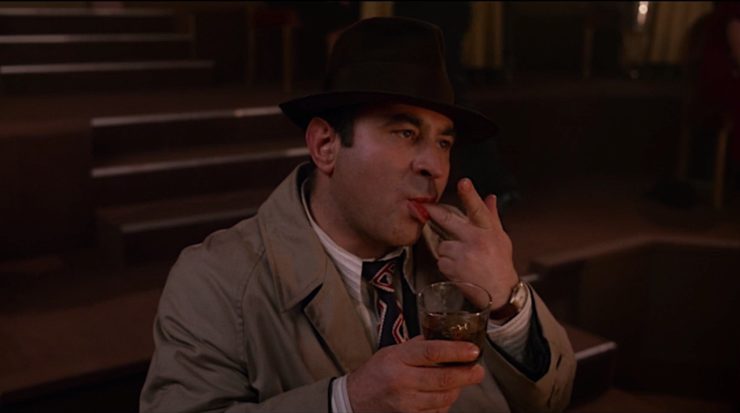
My parents ran a restaurant/bar for a while when I was a kid, but I think this was how I learned what “on the rocks” meant. Maybe more important, it taught me a Lewis Carroll-level lesson about the precision of language. But most important of all? That moment when Eddie Valiant sucks the bourbon from his fingers after he drops the rock (that the Toon waiters have, of course, included with the ice he requested) back into his drink. Eddie didn’t want to waste a drop of that liquor, did he? What did that mean?
And speaking of that…
“The liquor store guy, he knew!”
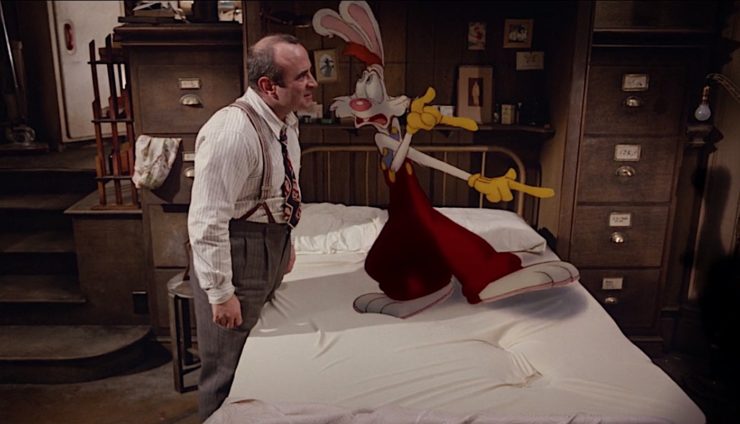
OK, so this wasn’t a life lesson so much as a harbinger of my future. (I’m fine, everything’s fine.) But it was interesting to Small Leah, growing up in a world of Wal-Marts and Publix—a glimpse of a society where you’d have actual relationships with the people who sold you groceries and household needs, and that in that world, the Liquor Store Guy could gain prime importance.
And speaking of THAT…
Public Transit > Cars
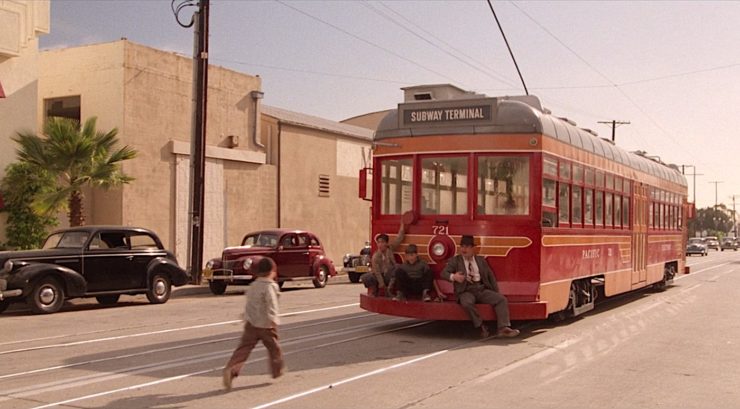
Long before this asinine faux outrage over 15-minute cities, Roger Rabbit taught me that what I really wanted was the ability to hop onto the back of a Red Car whenever I needed to go somewhere. (Or, y’know, pay a dime like a respectable person. Whatever.) Judge Doom’s freeway plan is terrible, so naturally it’s what we actually ended up with, and learning that most cities used to have reliable, cheap, clean, non-gas-guzzling-and-air-polluting modes of public transit, and that the powers that be CHOSE CARS INSTEAD, would have turned me into the Joker if I’d been old enough to become a vigilante. (You can go ahead and imagine my reaction to learning about Robert Moses.)
In Art, Detail Is Important
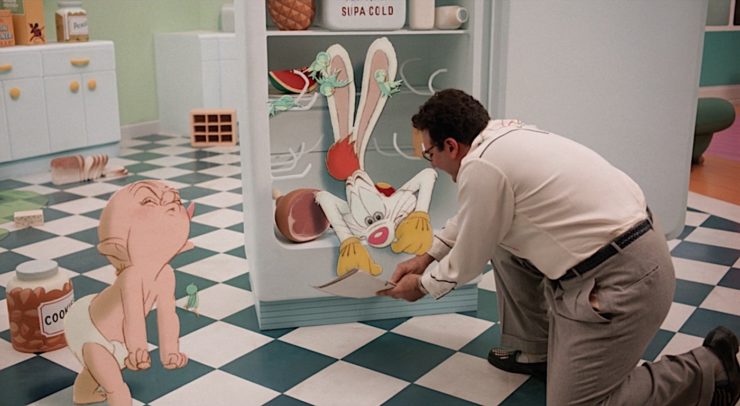
It’s a problem when Roger can’t produce stars, but instead only tweeting birds, when a refrigerator is dropped on his head. The whole picture depends on stars. Tweeting birds are fine, but they don’t add the pop that stars will, and Raoul wants this picture to be perfect.
Never settle for anything less than le mot juste.
That Annoying Honking Pattern Had a Name
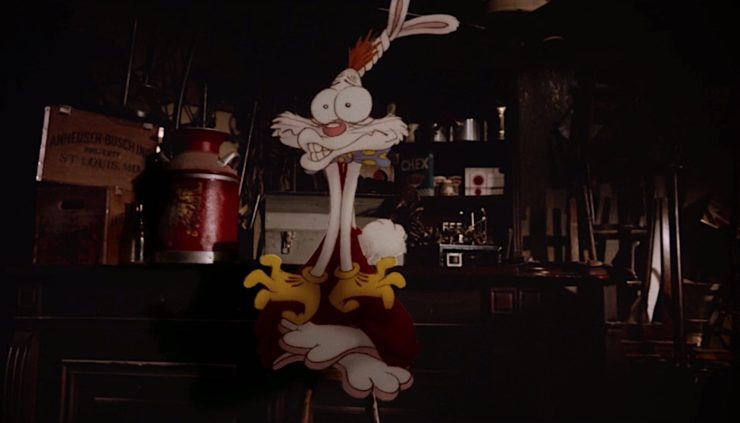
How many times had I heard “A Shave and a Haircut” honked out from cars? Thousands. But I had no idea there were words for it! That the pattern has a name, and an identity. Now, when there’s traffic on Flatbush Avenue and somebody decides to be a comedian, I think about Roger bursting through the wall and bellowing “TWO BIIIIITS”, and my rage at the horns subsides.
I Was Right—Mickey Mouse WAS a Total Bastard
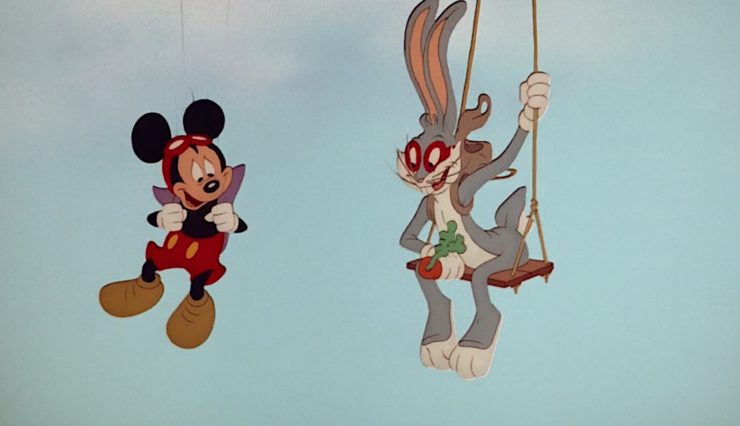
I always knew the Mouse couldn’t be trusted. He was too nice, too innocent. Here, in Roger Rabbit, I had my confirmation. When Bugs Bunny gives Eddie Valiant a spare tire instead of a spare parachute, that’s pretty much in character (not because Bugs is evil, far from it, Bugs Bunny is my greatest hero) but because it’s funny. And like all Toons, Bugs operates on a special type of physics and doesn’t think about Valiant being human. But Mickey, being Mickey, knows that what they’ve done is morally questionable, and allows it anyway. Mickey stands by and allows violence and pain to happen. He probably enjoys that pain, behind his rictus mask of “aw, shucks!” naivety.
Bastard.
Even Bad Guys Go to Heaven
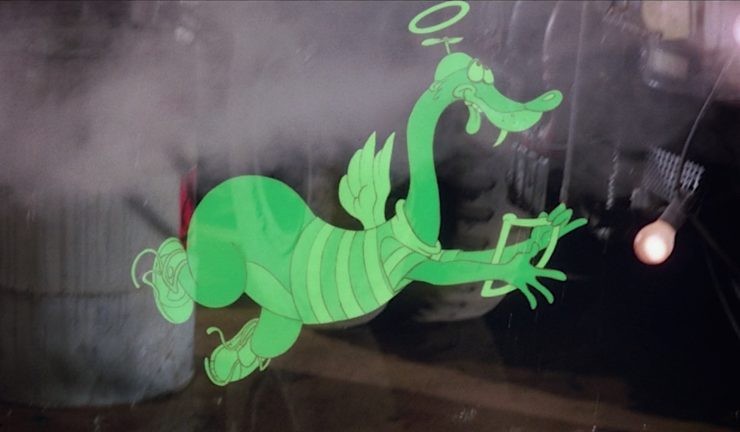
Bear with me a sec. We all agree that the weasels are terrible right? They’re Doom’s toadies, they’re violent and abusive and they’ve sold out their fellow Toons and they suck. AND YET. When they die they get harps and wings and float off into the sky, yes? What this implies is both that there is always, always a possibility of redemption, no matter how shitty someone is, and that Roger Rabbit takes place in a world of pure, wild, theological universalism.
The Shoe is still troubling, though. When the Shoe is dipped, we don’t see a spirit form. No harp, no wings. Can it be that the Dip causes a form of total annihilation? Would a benevolent Animator allow such a thing?
You Can Attract Hot Women by Being Goofy
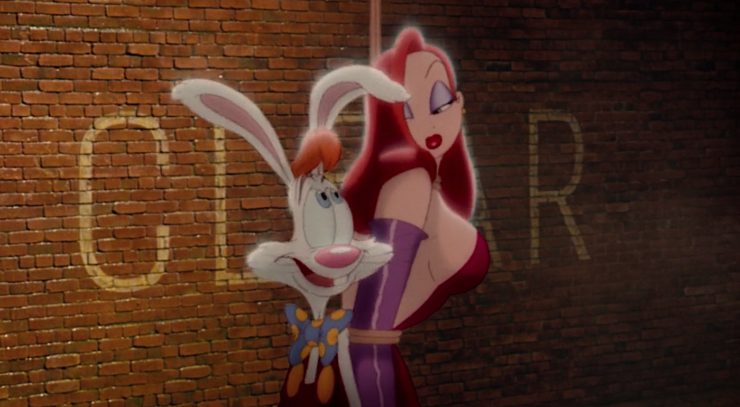
OK, not literally Goofy, he’s got his own stuff going on, but in all seriousness, my second-greatest goal in this life is to emulate Roger and Jessica’s relationship.
I, obviously, am Roger in this scenario. And speaking of THAT…
“I wrote her a love letter!”
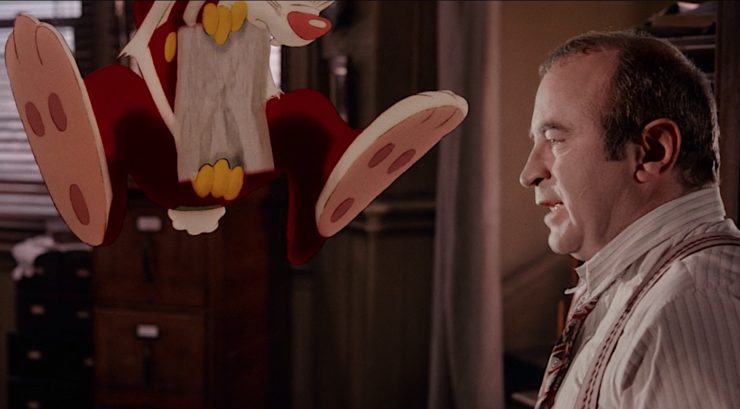
Eddie and Delores have been together for years. Years! Back in the Before Times, when Teddy was alive, she’d go on vacation with the brothers. Are she and Eddie married? Nope! But the way they interact implies a lot more than just casual dating, and it’s clear that their relationship has taken many shapes over the years, even while they still care for each other more than anyone else.
Meanwhile, Roger and Jessica are besotted with each other—Jessica is willing to make some questionable choices to save her husband, and Roger, for his part, never believes that she betrayed him despite all the evidence against her, and in the end the couple reunites with neither guilt nor resentment.
Biology Determines NOTHING
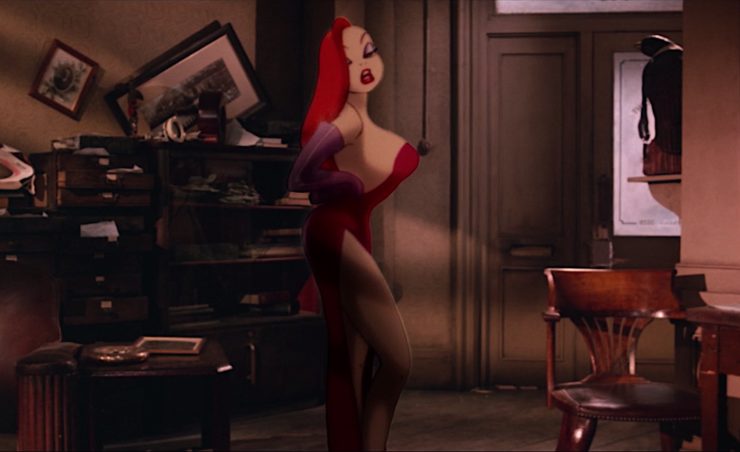
When Jessica Rabbit says “I’m not bad, I’m just drawn that way” what she means is that she’s not a stereotypical, Mary Astor/Barbara Stanwyck style femme fatale. She’s a good person with a great deadpan wit, but because she was drawn with ridiculous curves and a cascade of red hair, most people—Eddie, Dolores, the cops, the dudes at the Ink & Paint—only see her as an object. A cliche. But Roger knows who she really is, and more important she knows who she really is, so, to use language Roger would not: fuck ’em.
“Only when it was funny.”
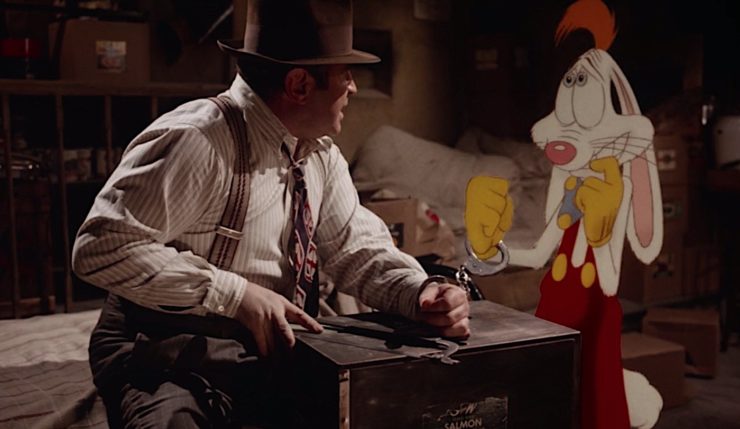
The most important moment of Who Framed Roger Rabbit? comes as Eddie tries to saw through the pair of handcuffs that have tethered him to Roger. To make this easier Roger slips his hand out of the cuff to hold the box steady. It takes Eddie a second to understand that he’s been attached to Roger for hours—leading to hilarious shenanigans, yes, but also real pain and real danger—and that the Toon could have freed the two of them at any time. But, as Roger explains, he couldn’t do it at any time—only when it was funny.
While an enraged Eddie tries to choke his client, Roger coughs out,“My whole purpose in life is to make people laugh!”
The idea that making people laugh could be a purpose—not just a job, like a comedian, but a calling, a personality, a moral imperative—I am not exaggerating when I say that single moment of film shaped the rest of my life. (Which, I know, isn’t funny. Imagine me getting a pie to the face while I type this.) Why slip the handcuffs right away when you can wait for the perfect moment? The moment that will destroy? It’s like that other scene I mentioned a few blurbs ago: the difference between tweeting birds and stars is important.
This idea has animated every decision I’ve made, steered me into some very interesting choices, and allowed me to laugh my way through some pretty dark times. I don’t know, maybe it wasn’t the best lesson to take from the movie, but it’s served me well.










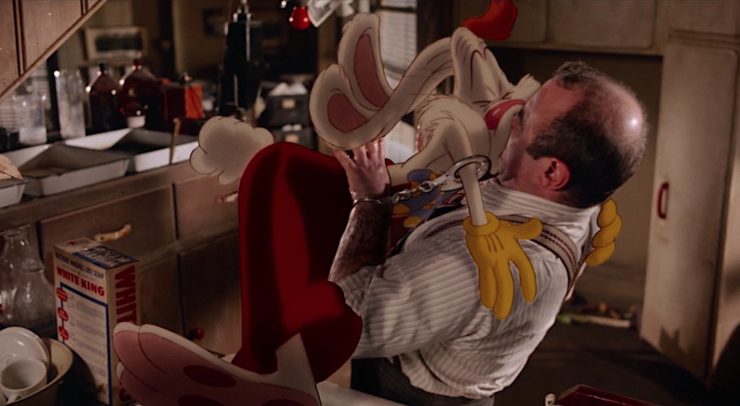
I watched this movie on VHS so many times a a kid and there are so many little nuggets like this that I never totally caught until I was older, haha.
The “That don’t rhyme with walls!” “This does!” is also an important lesson, haha.
I am here for all the theological speculation of the Toon verse, haha.
This movie gives back to us on sooooo many levels. Roger slipping out of his cuffs only when its funny gets me every time
“The best public transit system in the world, the Red Car!”
Dad was a model railroader and he had several HO scale Red Cars.
I can agree with very nearly all of this save for one critical point:
Who Framed Roger Rabbit is in no way, shape, or form a “kids’ movie”.
It is, I grant, considerably more kid-friendly than the novel on which it was based, and that by design. But it was neither made nor marketed primarily for kids – which was one of the reasons the producers were able to get the rights to include characters from under different corporate umbrellas in the same picture. Rather, it occupies the same much-neglected niche as The Muppet Show, a property made for and marketed to an audience deliberately inclusive of kids and adults.
Which, if anything, makes the film even more remarkable.
Great set of lessons. wrt sucking his fingers, we’re shown that Eddie is a habitual alcohol user (dumping out his hip bottle before going into Toontown is a turnabout) and not doing very well economically; I figure he wasn’t going to let any hooch go to waste. Or he could just have been being ~neat.
One of my very favourite movies – I’ve seen it countless times, far more than I’ve seen any other individual film, and yet I find something new in it nearly every time. It’s an absolute wonder. I don’t want to call it improbable, because there were too many people on board who really knew what they were doing (Robert Zemeckis, Richard Williams, actors, pretty much everyone), but I’m always struck by how well it works and how many subtle things were thought out staggeringly well.
Oh what a marvelous and delightful essay. Thank you <3
@6/ chip137
Well played. Roger would be proud.
+1 to @5. Spot on.
I was 17 when the movie came out, ripe for its meta nature and musings on the nature of storytelling. There’s a melancholy that suffuses so much of it, alongside the adventure and technical achievement and awesome intercollegiate ensemble of famous animated characters, due in part I think to a tension between points that Leah makes about Roger being a slave to his toon nature and Jessica’s trademark line. I watched it a year or so ago, for the first time in a while, very happy that it still holds up.
John C. Bunnell @5, and the post title, get the name of the movie right in leaving off the question mark. Could be a promise going in from the filmmakers that we’ll get the mystery solved or just a matter of style, but there’s a huge difference in the interrogative vs. declaration.
Let’s not forget that, true to “Red Hot Riding Hood” form, Who Framed Roger Rabbit? had Jessica singing a classic jazz number and scorching the room with it.
Regarding the lack of a question mark in the title, I read once that there’s a Hollywood superstition that says movies with a question in the title don’t do well. I actually wondered if the title wasn’t even a question, but a statement — that in watching it, we would find out “Who Framed Roger Rabbit.”
Also in homage to the time-period, the Daffy – Donald “dueling pianos” scene featured Liszt’s “Hungarian Rhapsody No. 2,” an often-parodied piece used in the classic Warner Bros “Rhapsody Rabbit” and MGM “The Cat Concerto.”
And Daffy was drawn very much “in period,” with the loose, rubbery animation and maniacal energy of the mid-1940’s Bob Clampett– and Bob McKimson–directed cartoons.
I once moderated a panel at OryCon called “I’m not bad, I just draw that way’ about the resources available for us non-artistic folk.
What a wonderful article.
I’m a huge fan of the movie and had never thought of some of those.
My favourite line is still “I’m not bad, I’m just drawn that way”. And it’s a film that just doesnt age.
Thank-you.